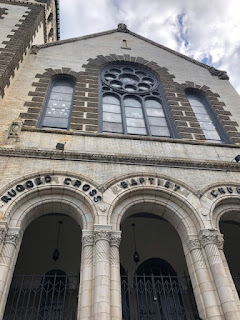The other day, before I wrote my 9/11 commemorative piece, I took a ride: a ramble through Queens and Brooklyn on Tosca, my Mercian fixed-gear.
My ride included some familiar streets and sights. But I also took in some streets--or, more precisely, segments of them--I hadn't ridden before.
One of those thoroughfares, Carroll Street, spans the breadth of Brooklyn in two sections. The first begins at Hoyt Street, near the borough's downtown hub and cuts through the brownstone neighborhoods of Carroll Gardens and Park Slope on its way to Prospect Park. On the other side of the Park, Carroll continues along through neighborhoods less known to tourists: Prospect-Lefferts Gardens, Crown Heights and Ocean Hill-Brownsville. It was along that second section, in Crown Heights, that I chanced upon these houses:
They combine the brownstone facades one sees on the other side of the park with Victorian-style cornices--and rounded, almost turret-like fronts I've seen only in Ridgewood and a couple of other Queens neighborhoods. That block of Carroll--between Kingston and Albany Avenues--lies in the heart of the Hasidic neighborhood of the Heights.
After I took the photos, I walked Tosca (Carroll is a one-way street) to check out a store where I didn't think I'd buy anything but I wanted to see because it's unlike any in my neighborhood of Astoria, or in most other places.
Turns out, the place moved around the corner, to Kingston Avenue. I peeked in; the young man working in it knew full well that I wasn't from the community and therefore wouldn't buy the mezuzahs (Star of David medallions found on the doorways of homes), prayer shawls or other items ultra-Orthodox Jews use in their daily lives and worship. But he didn't seem to mind my being there and we exchanged greetings of "shalom" on my way in and out.
As I turned to my left, I noticed an alleyway in the middle of the block.
The first painting, closest to the street, seems like a conventional representation of a Torah lesson--until you look closely. But the sky-blue background gives the scene an almost ethereal feel and the rabbi's expression makes him seem, simultaneously, like a relative and an ancestor, as if the kids might be in a room with him or that he might have come to them in a dream or vision.
To their left were two other murals. Is the girl--woman?--in awe or fear? I couldn't help but to think about Edvard Munch's "The Scream"--which, I'm sure, the artist intended. But is it a scream of ecstasy or terror, or something else? I might've asked the same questions about the man in the other mural which, of course, evokes Van Gogh's "Starry Night."
Even though the compositions echo (pun intended) Munch and Van Gogh, I felt that the artist's real inspiration may have been one of the greatest Jewish modern artists: Marc Chagall. At least, the colors--themselves and the way they play off, with and against each other--reminded me of his paintings and the stained-glass windows he created for the cathedral of Reims, France, to replace the ones blown out during World War II. In fact, in walking past the murals with Tosca, I felt as if I were in an open-air temple or synagogue.
On the other side of Kingston is another alley, with this portrait by the same artist:
I thought it was interesting how that artist used blue differently from the way it's used in the painting of the Torah lesson. Here, it makes the man--whom I assume to be, if not a rabbi, then at least some sort of elder in the community.
It never ceases to amaze me how taking a random turn during a ride in my city can take me on a journey!
















.jpg)



























